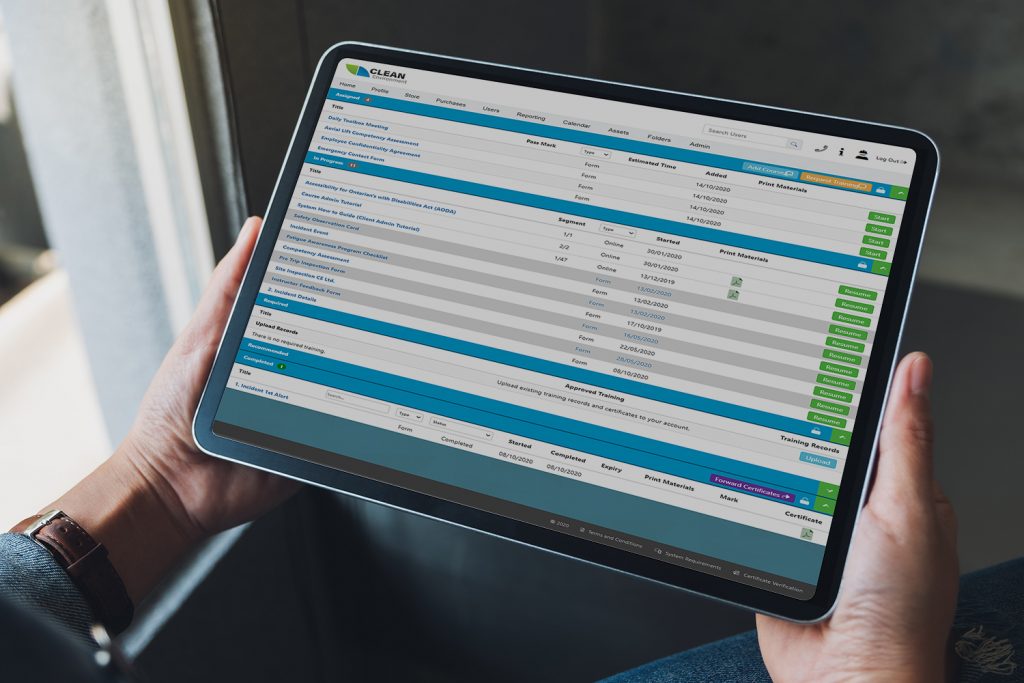
Do You Need a Learning Management or Training Management System?
A Training Management System (TRMS) and a Learning Management System (LMS) are both used to manage competencies and training in organizations. Some of their functions are similar, but there are also major differences between the two systems. Trying to decide between a TRMS and an LMS would be like choosing between project management and BIM software; they are complementary solutions, rather than competing options.
- A Learning Management System can be used to manage the entire training process in a company. The functions of an LMS include course scheduling based on the job position, hosting and delivering course material, and applying tests.
- A Training Record Management System is also used to manage training, but with a greater focus on safety and compliance, not the courses themselves. For example, if a company gets an inspection, a TRMS can be used to generate reports that show training certificates and other key documents.
A company can create employee profiles in an LMS and a TRMS, which include information like the courses completed so far and the training planned. When an organization uses both systems, plenty of interaction can be expected. For example, the TRMS can send an automatic reminder when important certificates are about to expire, and the courses required for renewal are assigned using the LMS.
Let’s compare the main benefits of both software solutions, LMS and TRMS, and how they can help an organization:
LMS Features and Benefits: Top 3 Uses for Learning Management Systems
The training requirements of a company depend in great part on the industry sector, and two employees in the same firm may require very different courses based on their roles. When an organization deploys an LMS, the following are three of the main benefits:

1) Creating In-House Training: A company that uses an LMS has greater control over its training programs. They can purchase courses from different providers, and combine them into customized training programs for each job position. In other words, employees can learn with the best courses from different providers, and companies don’t depend on a single provider for their training needs.
2) Delivering Courses Online: While traditional courses in a classroom have their benefits, they are impractical for many modern companies. For example, if many employees must take the same course, finding an hour that works for everyone can be very difficult. This is especially true for companies that operate across different cities and timezones. An LMS eliminates this limitation since employees can choose when to take the course individually. Even with modern technology, some types of training must still be in-person. For example, a construction equipment operator must gain experience before driving trucks on an actual project site. For training needs that are based on information and concepts, online courses are now accepted by most jurisdictions and industry authorities.
3) Assign Competency Assessments and Exams: The functions of an LMS go beyond delivering courses for employees. The system can also be used to configure and apply exams, and it can support functions like remote proctoring, which may be required to approve some courses. Taking tests can be a stressful experience, but there are many features that can make the process engaging and motivating. For example, a course can be gamified with achievements and high scores. Just like with training material, companies can use the exams from content providers, or they can develop their own.
TRMS Features and Benefits: Top 3 Uses for Training Record Management Systems
As previously mentioned, an LMS and TRMS complement each other. While an LMS is designed to plan and deliver courses efficiently, a TRMS can manage training documentation for compliance purposes or to meet company policy. When using a TRMS, the following are three of the main benefits achieved:
1) Training Certificates Management: Safety authorities like OSHA have mandatory training requirements for many job positions, and certificates may be requested as proof. This is especially common in heavy industries like construction and energy, where lack of training can lead to severe accidents. Companies must be prepared for regular inspections, which are not announced in some cases. A TRMS is very useful for managing the required documentation, such as the training certificates of each employee. These certificates are only issued by authorized content providers, and they often have an expiration date. At this point, an updated course is typically required for renewal.

2) Training Notifications: When the expiration dates of certificates and licenses are monitored by a TRMS, a company can get automatic notifications. This way, any courses necessary can be scheduled in advance. On the other hand, if a training certificate is allowed to expire, the employee may be forced to stop working until the renewal requirements are met. This can be very disruptive for projects, and there may be penalties if there is a surprise inspection. A TRMS can keep track of training certificates with ease, even if a company has thousands of employees. In these cases, keeping track of all documents manually would be very time-consuming, and prone to human error.
3) Reporting and Analytics: A large volume of data can be confusing when presented by itself, providing less value for decision-makers. On the other hand, a TRMS can generate user-friendly charts and reports automatically. Consider a long table with employee names and certificate expiry dates. At a glance, there is no indication of which dates are sooner than the rest. However, if they are automatically colored and filtered by urgency, short-term expirations become evident and the necessary courses can be planned. Without user-friendly formatting, a date within two years does not look very different from one within two months.
Reporting and analytics functions are not exclusive for a TRMS, and they also add value when used in an LMS. For example, an LMS can generate a training matrix to report which courses have been assigned to each employee, and their completion status. In both cases, software can draw information from large databases in an instant, a process that could take hours manually.
TRMS or LMS: Who Needs Each Type of System?
As mentioned above, a TRMS and an LMS are not mutually exclusive, and both can be used in the same organization. However, depending on the business sector and activity, one system may offer more value than the other one:
- Heavy contractors with plenty of equipment will definitely benefit from a TRMS, for example. Managing training certificates for all the operators in charge of a large fleet becomes much simpler with a software solution.
- On the other hand, an LMS is useful when companies want to assume control over the training process. For example, a consulting firm may deploy an LMS to provide training about a specific topic.
A company can also rely on both an LMS and TRMS, as complementary solutions. For example, a large firm in a heavy industrial sector will be subject to stringent regulation, creating an excellent opportunity for a TRMS. However, this same company may decide to manage all training programs internally, which is simplified with an LMS.
When using a TRMS and LMS, no system can be considered “better” than the other, since each has its own purpose. A TRMS is a powerful tool for safety management and compliance, while an LMS provides a dashboard to manage all aspects of training in a company. An LMS can be used to provide mandatory courses, which generate the certificates managed by the TRMS. However, an LMS can also provide courses that are not required by law, where the goal is continuous improvement.






























